Summary of Luminism
Just before the outbreak of the Civil War, a handful of landscape painters, instead of painting monumental, dramatic scenes of American wilderness, began painting on a smaller, quieter scale. The Luminist style had much in common with the Transcendentalist writings of Ralph Waldo Emerson and Henry David Thoreau, which advocated that one immerse oneself in nature in order to know oneself and the divine. While the artists did not cohere as a unified movement, they did share stylistic tendencies. Marked by a certain rendering of light as a uniform glow that infuses the entire scene, Luminist paintings reveal no brushstrokes of the artist, thus maintaining a silent, almost impersonal, surface. The particularly American style has continued to influence contemporary landscape painting.
Key Ideas & Accomplishments
- While partly influenced by Romanticism, Luminist paintings do not tend to depict nature as grand and imposing, nor do they strive to convey a sense of spectacular, awe-inspiring sublimity. Instead, Luminist paintings with their smaller size evoke a quiet spirituality based on closely observed natural phenomena, especially the quality of light.
- Luminist light is particularly distinct. It is often cool and hard, almost palpable. The painters use slight tonal modulations, and not brushstrokes, to create the effect of radiant light.
- Luminist compositions are very ordered, emphasizing the horizontal expanse with a deep spatial recession. The surfaces are precisely rendered, leaving no hint of brushstrokes. This clarity of the picture plane facilitates the viewer's communion with the natural scene presented and lends the scene a certain silence.
Artworks and Artists of Luminism

Pittsford on the Erie Canal
This proto-Luminist landscape depicts the Erie Canal and focuses on the canal's quiet waters reflecting the light of the softly glowing sky. On the tree-lined road along the edge of the canal, two horses are driven by a man on horseback, while at the bend in the low middle distance a boat comes into view around the curve known as King's Bend. The hill on the right is subtly illuminated by sunlight, and a number of ducks swim along the banks of the canal. The painting conveys a feeling of quiet serenity, as the canal takes up the foreground of the painting and draws the viewer's eye toward the low horizon where the small town of Pittsford is visible beneath the autumnal sky, but the town does not disturb the natural configurations of the land.
This work employs Harvey's innovative stippling, where he placed tiny points of color adjacent to one another to create an effect of light, a technique that prefigured the Neo-Impressionist technique of Pointillism. The canvas is naturalistically detailed in its depictions of the horses and the boat as well as the seasonal indications such as the crimson leaves on the trees to the left and the bare saplings outlined on the hill to the right. The emphasis on atmospherics, the subject matter focusing on a body of water that reflects the sky and seems to flow into it, and the open composition favoring the curvilinear in its depiction of the canal and the horizon, along with the intimate scale of the canvas, made this prototypical of the Luminist landscapes that would follow over the next 20 years.
Watercolor - Fenimore Art Museum, Cooperstown, New York
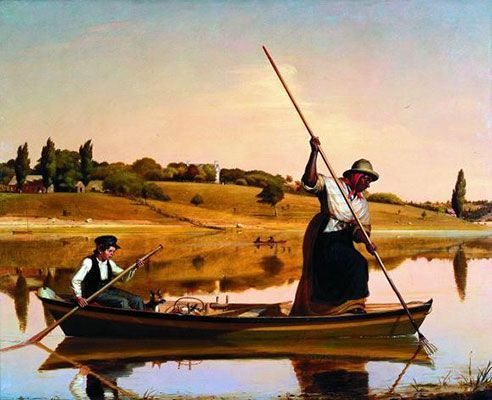
Eel Spearing at Setauket
Mount's Eel Spearing at Setauket is more often classified as a genre painting, but it shares Luminist aspects that others would more fully develop in the following decade. While depicting a common activity, the painting also depicts the still waters that reflect the farmland in the background and the glow of the sky. Despite the action of the figures, there is a quiet and undisturbed mood about the scene that is common of many Luminist works.
Sometimes criticized for having a provincial quality, Mount studied at the National Academy of Design in New York, and his awareness of the European art tradition can be seen in his triangular composition and the dignified classicism of his figures. At the same time, his work was informed by the American naïve style's emphasis upon bold outline and simplified elements, as shown in the sharp relief of the two figures.
Oil on canvas - Oil on canvas
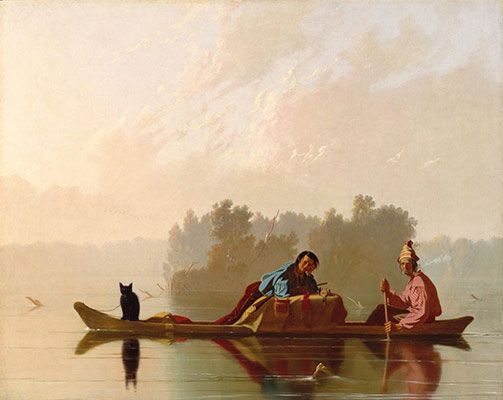
Fur Traders Descending the Missouri
This painting depicts a dugout canoe, bearing two men and a black bear cub, tied to one end, as they descend the Missouri River to St. Louis. The older man on the right wears a Phrygian cap, a French symbol of liberty marking him as a French fur trader, and placing the image within an earlier historical period, when this part of the country was a French territory dominated by the fur trade. The young man, leaning on the cargo in the center of the boat, is the man's son, and his clothing and the beaded medicine pouch near him reflects that he was part Native American.
The waters are remarkably still and reflective, as shimmering horizontal lines depict the hidden currents that break around a submerged tree limb in the foreground. In the middle distance to the left, submerged trees rise out of the water, creating a diagonal to the island that frames the two men on the canoe. As a result, the figures come into sharp relief, as the landscape becomes an atmospheric harmony of the river, the hazy distant forest, and the luminous sky, thus creating an examplary Luminist structure.
Oil on canvas - The Metropolitan Museum of Art, New York

Off Mount Desert Island
Here, Lane depicts a quiet cove along the coast of Maine where a large sailing vessel lingers at the center right edge of the canvas and a smaller boat lurks in the shadows at the left, almost as if an afterthought. Most prominently, Lane paints the sunset glow in the pink clouds that rise out of the island mountains reflecting in the ocean waters. The sparseness of the scene ensures the dominating effect of the sky and the water.
The artist took summer cruises in this area beginning in the late 1840s, and the vastness and wilderness of the landscape became one of his favorite subjects. Like most of his Maine seascapes, this work emphasizes the atmosphere and emotional effect of the coast. With the exception of the boats and a few birds, the landscape is unpopulated, thus heightening the opportunity to be in communion with nature without the distractions of others. Here, one can notice the cragginess of the dead trees in the foreground and further into the scene on the next island. Unlike the Hudson River School painters such as Albert Bierstadt and Frederic Church, Lane eschews dramatic effects, favoring a subtle composition and rhythm as seen in the way the three peaks on the island lead one's gaze to the ship on the horizon. He also adopts an aerial point of view, and his emphasis on subtle tonal gradations, drawn from his experience in printmaking, gives his painting a sense of lyrical restraint.
1856 - Brooklyn Museum, Brooklyn, New York
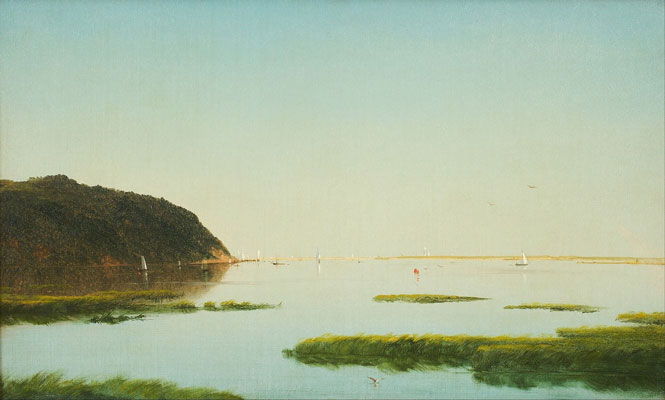
View of the Shrewsbury River, New Jersey
This landscape, depicting the Shrewsbury River, emphasizes the silent expanse of water against a thin curve of the horizon, a line of golden light that barely outlines the cloudless subtle blue variations of the sky. A land formation, covered with vegetation, lines the river, and small sailboats dot the horizon. One buoy punctuates the near center with its bright red, contrasting with the pale blues of Kensett's characteristic palette.
Kensett emphasizes a contemplative and poetic experience of nature, grounded in quietism, and to achieve this effect he often minimalized the landscape to its essential elements. He creates an emphasis on line and form that give the landscape a more abstract feeling than one is accustomed to. Kensett was able to create an intimate encounter with nature, where the stillness of the landscape became a way to connect with an inner sense of space and silence. His proto-modern minimalism had a profound effect on the Post-Minimalist Richard Tuttle, who said that the artist's light, which has a self-generating energy about it, influenced his own work.
Oil on canvas - Zimmerli Art Museum at Rutgers University

The Wilderness
A rugged mountain stands outlined against the horizon and reflected, as if in a mirror, in the glassy lake below. In the lower left, a single figure, a fisherman, can be seen in shadowed profile before a large overhanging rock. The painting's finished reflective surface, as if an image on glass - without any trace of brushstroke, creates an effect of crystalline clarity, while the atmospheric haze above the horizon that cloaks the mountain shimmers with a golden glow.
An ardent fisherman Gifford was drawn to spending his summers fishing and painting and perhaps painted himself into the corner of this canvas. Whether or not the figure represents the artist, the solitary individual experiences an intimate encounter with nature in search of the inner knowledge that the Transcendentalists understood nature's light bestows. Gifford, more than other Luminists, followed more closely the styles of Cole and Church in his depictions of the contemplative sublime landscape.
Oil on canvas - Toledo Museum of Art, Toledo, Ohio
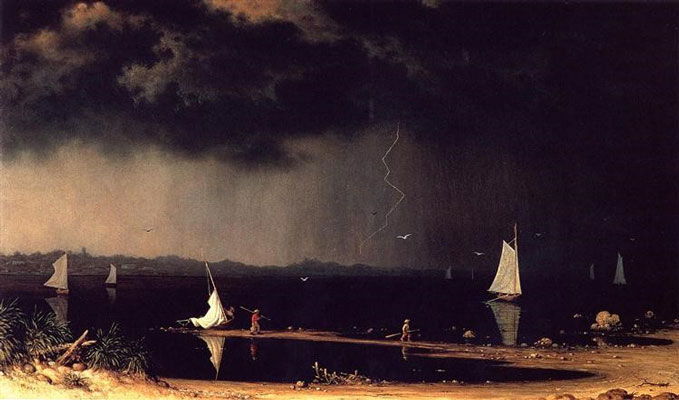
Thunderstorm over Narragansett Bay
This seascape depicts a thunderstorm over Narragansett Bay. Heade emphasizes the impending storm, with the billowing clouds overhead blackening the sky to the right, lit up by a single jagged lightning bolt. Despite the oncoming storm, the water is black, glassy, still, and a number of sailboats on the left and right seem stationary. Two small human figures walk shoreward, away from a docked boat, its white sail in partial collapse. The painting creates a sense of hushed expectation, an ominous pause just before the storm's outbreak, and in the narrow sunlit foreground to the left a cross like shape has fallen over.
This painting with its emphasis on subtly shifting perceptions of light and atmospherics within a simplified spatial composition is an iconic work of mature Luminism. The horizontal arrangement of the composition, with two thirds of the picture given to the storm filled sky, results in a minimalistic flatness. Heade's emphasis on stormy atmospherics set his work apart from the more serene views of the other Luminists, though he also eschewed the overly dramatic treatment of the Romanticists. When this work was shown in 1868, a newspaper critic found it "hard and chilling," and, yet, it is this very sense of unflinching observation and flatness that makes the work distinct. In the work's fallen cross and the ship returning to the shore prior to a storm, a common 19th-century metaphor for the course of human life, there is a hint of an allegorical and pessimistic tone. Heade's work seems modern and continues to influence contemporary artists like Keith Jacobshagen, whose oil landscapes on copper plates often depict an intensely lit slice of foreground beneath a darkening sky which fills the picture frame.
Oil on canvas - Amon Carter Museum of Modern Art, Fort Worth, Texas

The Buffalo Trail
While Bierstadt is most famous for his large scale, dramatic paintings of the American West, many of his works have much in common with the Luminist style. In The Buffalo Trail, Bierstadt paints the landscape with a low horizon that emphasizes the wide open plains. The light from the sun, shadowed by a cloud, reflects brightly in the river that the buffalo cross.
In attempting to picture the West for his East coast patrons, Bierstadt tried to tap into nationalistic feelings that accompanied the 19th-century idea of Manifest Destiny, the idea that America should extend from the Atlantic to the Pacific Oceans. He would travel in the West, making sketches and paintings that he would later use to create monumental paintings back in his New York studio. As curator John Wilmerding remarks, "One reason luminism so suited exploration painting and photography was that it was literally involve in the measurement of landscape." Bierstadt gives the viewer a measured, symmetrical, and harmonious view of nature that draws attention to the center light of the scene, the real subject of the luminist painting.
Oil on canvas - Museum of Fine Arts, Boston
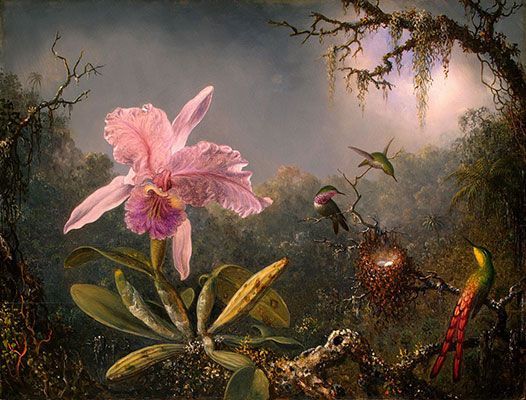
Cattleya Orchid and Three Hummingbirds
While still nominally a landscape, Heade's painting has much in common with a still life, an unusual subject matter for most Luminists. This painting depicts a close up of an orchid and three hummingbirds framed by an overhanging moss-covered branch with the sun lighting up the clouds behind it. The two birds on the left are Brazilian amethyst-throated hummingbirds, while the bird perched on the branch is a red-tailed comet or Sappho's comet, known for its resplendent tail feathers. The artist uses precise naturalistic detail in his treatment of the orchid's leaves, the veins of its blossoms, and the near translucency of some of the petals that point toward the upper right, drawing the viewer's eye to the atmospheric sky.
Heade began exploring this new subject matter after various trips to South America beginning in 1863, where he was drawn by the influence of his friend, Frederick Edwin Church. Working on a series called The Gems of Brazil, Heade combined meticulous observation of the natural environment, influenced by the writings of Charles Darwin, with a Luminist landscape to convey a sense of nature's sublime beauty in even its smallest creatures.
Oil on mahogany panel - The National Gallery of Art, Washington DC

Lake Wawayanda
Cropsey, a figure on the edge of Luminism, depicts Lake Wawayanda in New Jersey, using delicate tones in the treatment of the autumnal foliage on the left shore, the glowing light of the descending sun, and the tranquil lake's subtle reflections. The canvas is divided in half by the horizon, giving equal attention to the lake and the sky, in order to convey a sense of measure and balance. The gentle shapes of the mountains on the horizon, echoed in the closer hills, draw attention back to luminousness of the lake, and the overall effect is pastoral.
Cropsey began visiting this area in 1843, and this painting exemplifies his mature Luminist style that conveyed a serene and celebratory mood. For viewers of his time that mood connected with the arrival of the American centennial, of America's having weathered the Civil War era, and of entering a time of economic expansion. At the same time there was nostalgia for pristine landscapes of the past, and, accordingly, the artist leaves out any sign of human habitation and presents the lake as occupied by only a small animal swimming in the middle distance. As a result, his view is a Romantic one, rolling back time to present a somewhat idealized view, though his work was most influential in its using subtle gradations of color to create tonal variation and cohesion.
Oil on canvas - Allen Memorial Art Museum, Oberlin College, Oberlin, Ohio
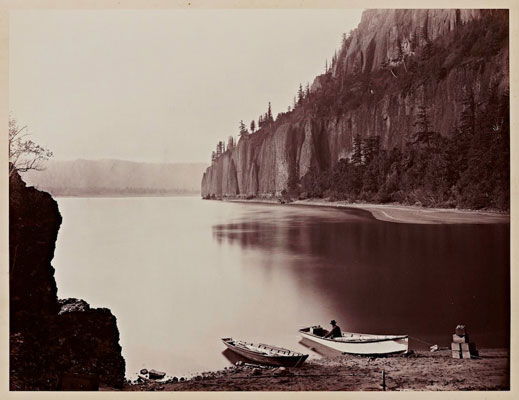
Cape Horn, Columbia River
While Luminism generally refers to a style of painting, photographers began using Luminist elements in their photos of nature as they increasingly took their cameras out of the studios. Here, Watkins presents the viewer with a very structured view of a cove on the Columbia River. As in many Luminist paintings, the human presence, if there is any, is very small. Here, a man prepares to go out on the river in his boat but is largely overshadowed by the steep cliffs that loom above him. The river seems remarkably still, and the rock face is reflected on the surface. One realizes that the brightness of the water comes from the mirroring of the washed-out sky above. While the photograph captures a specific moment in a particular place, Watkins' composition, with its emphasis on the reflectivity of the water's surface, plays with the ambiguities of the real world and the reflected world and suggests the need for the quiet contemplation of nature that the Transcendentalists espoused.
Albumen photograph
Beginnings of Luminism
To Start: Defining Luminism
Luminism refers to a type of American landscape painting that became most prominent in the 1850s and lasted into the 1870s practiced among artists associated with the Hudson River School. The artists did not identify themselves as Luminists, as the term wasn't coined until 1954 when the art historian and director of the Whitney Museum of American Art, John I. H. Baur, used it to describe these naturalistic landscapes, often seascapes or river views, emphasizing the treatment of light to create a contemplative and luminous effect. Baur defined Luminist work as, "a polished and meticulous realism in which there is no sign of brushwork and no trace of impressionism, the atmospheric effects being achieved by infinitely careful gradations of tone, by the most exact study of the relative clarity of near and far objects and by a precise rendering of the variations in texture and color produced by direct or reflected rays."
Early Developments
The painters who developed the style that later came to be called Luminism had varying backgrounds and training. Barbara Novak, the art historian, whose Nature and Culture: American Landscape and Painting 1825-1875 (1980) defined and advanced the recognition of Luminism wrote that the origins of the movement were "mysterious" and that it was "one of the most truly indigenous styles in the history of modern art."
Lacking a definite point of origin, Luminism nonetheless reflects a number of influences, most notably 17th-century Dutch paintings, naïve genre art of 19th-century America, the philosophy of Transcendentalism, and photography and printmaking. The development of the Luminist style can first be seen in the works of George Harvey and the genre artists George Caleb Bingham and William Sidney Mount, and reaches maturity in the works of notable master landscape artists, Fitz Hugh Lane, Martin Johnson Heade, Sanford Gifford, and John R. Kensett.
George Harvey: Atmospheric Landscapes
Harvey, a British artist known for painting miniature portraits and watercolor landscapes, came to America in 1820 seeking his fortune and began making connections with the artistic and literary community in New York City. He became interested in what he called "the ever-changing atmospheric effects" of the North American landscape and in the 1830s began working on a watercolor series "Atmospheric Landscapes of North America," that occupied him until the early 1840s.
His intent was to show what he called, "the course of the day," by focusing on particular areas in different seasons and times of day. He was influenced by Thomas Cole's ideas of nature as cyclical, expressed in Cole's Course of the Empire series, and also drew upon the works of well-known writers associated with the Hudson River School. For instance, his Daybreak: Leather-stocking's Expedient (c. 1830s-40s) combined his atmospheric landscape with a scene from James Fenimore Cooper's novel The Prairie (1827). In 1841 Harvey published Atmospheric Landscapes (1841), which combined his watercolors with etchings of his landscapes by William J. Bennett, and he exhibited the oil paintings and watercolors in 1842 at the National Academy in New York. To reach a larger audience he subsequently reproduced the images on glass lantern slides to be presented in tours of Britain and America, where his work came to the attention of artists associated with the Hudson River School.
Second-generation Hudson River School
Most of the artists associated with Luminism were part of a second generation of Hudson River School painters. The origin of the Hudson River School can be traced to 1825 with Thomas Cole's landscapes of the Catskill Mountains, as seen in his Lake with Dead Trees (Catskill) (1825). Cole's Romantic landscapes focused on pristine wilderness and helped bolster a rising national awareness of America as an unexplored and uniquely beautiful environment.
Following Cole's death in 1848, Frederic Edwin Church painted grand, pastoral scenes of the American landscape that fused the real and the idealized, and he went on to paint the South American wilderness on a panoramic scale, as seen in The Andes of Ecuador (1853). These and later more dramatic landscapes evoked the experience of the sublime - the individual's precarious place in the midst of an overwhelming nature. Church's ability to capture the light and atmosphere of a place paved the way for the Luminist painters that would follow.
Asher B. Durand, a painter of precise and humble landscapes, wrote in 1855 that new painters should eschew the dramatic and sublime and focus instead on "the 'lone and tranquil' lakes embosomed in ancient forests, that abound in our wild districts, the unshorn mountains surrounding them with their richly textured covering, the ocean prairies of the West and many other forms of Nature yet spared from the pollution of the civilization." His words would become guides for a new generation of landscape painters.

Following in the footsteps of Church and Durand, another group of second generation Hudson River School painters included Fitz Hugh Lane, Martin Johnson Heade, and John Frederick Kensett who developed the Luminist style which came into maturity in the 1850s. By the 1850s, America had changed from a country marked by large areas of wilderness to a more pastoral landscape, populated by small towns and growing cities, connected by railway systems and the Erie Canal. As a result the river views and seascapes of the Luminists depicted places where signs of human habitation and activity were always present. In their small intimate canvases, they sought to convey a sense of the individual in communion with nature, a quiet state of contemplation.
Naïve painting

Naïve, or folk, art was an important influence upon the development of Luminism, particularly as seen in the works of William Sidney Mount and George Caleb Bingham. But other Luminist painters were influenced as well by the naïve style. Martin Johnson Heade's teacher and mentor was Edward Hicks, best known for his Peaceable Kingdom (1826), which depicts a Biblical scene in an American landscape, and was one of the 19th centrury's most reproduced works. While depicting an altogether different subject matter from Hicks and other folk art painters, Luminism drew upon the naïve tradition's linearism, bold outlines, and its minimalized elements to compose the landscape itself.
17th-Century Dutch Landscapes
Noted Luminist works like Lane's Owl's Head, Penobscot Bay, Maine (1862) and Kensett's View of the Shrewsbury River, New Jersey (1859) show the influence of Dutch landscape painting. A number of noted American art collectors who became patrons of the Hudson River painters had collections of 17th-century Dutch paintings, and works by the likes of Aelbert Jacobsz Cuyp, Aert van der Neer, Salomon van Rusdael, and Jacob van Rusydael were also shown at public exhibitions. As a result, the Luminists were influenced by Dutch subject matter of atmospheric landscapes with bodies of water as seen in Saloman van Rusydael's River Landscape with Ferry (1649), as well as the Dutch artists' horizontal compositions that emphasized spatial recession. The Luminists, though, gave less importance to the sky and more often emphasized the middle ground with its view of a body of water.
Luminism: Concepts, Styles, and Trends
Transcendentalism
Transcendentalism was an American philosophy developed and expounded by Ralph Waldo Emerson beginning with his essay "Nature," published in 1836. Influenced by the theology of Unitarianism as well as the philosophy of Immanuel Kant and European Romanticism, Transcendentalism emphasized communion with nature as a connection to a higher or 'transcendental' knowledge and objected to the corrupting forces of institutions on individuals. In "Nature," Emerson wrote that the human soul "is not an organ...not a faculty, but light...." Light, he felt, made the world "transparent" so the "light of higher laws than its own" can shine through it. Emerson established the Transcendentalism Club in 1836 in Cambridge, Massachusetts and was joined by many of the leading writers and thinkers of the time.

Emerson became a lifelong friend and influence upon Henry David Thoreau who chronicled his simple self-reliant life in a cabin for two years in Walden: On Life in the Woods (1854), which became a founding text for later environmental and ecological movements. While none of the Luminsts were to explore such habitation practices, many of them followed in Thoreau's footsteps by living or spending parts of the year on the coast of Maine and the shores of New York where they not only engaged in painting but camping, fishing, and boating. Living not far from city centers, just as Thoreau's Walden Pond was not far from the town of Concord, they experienced nature not as wilderness but as restoration and inspiration.

Either through direct influence or an affinity with Emerson's views, Luminists focused primarily on light itself, its effects and atmospherics, and created canvases where brushstrokes and signs of the artistic process were all but invisible, so that the viewer would feel as Emerson wrote, "my head bathed by the blithe air, and uplifted into infinite space, all mean egotism vanishes. I become a transparent eye-ball; I am nothing; I see all; the currents of the Universal Being circulate through me; I am part or particle of God." Out of this philosophical foundation, the landscape artists of the second generation Hudson River School moved away from dramatic and sublime depictions of nature and toward a nature infused with a divine light.
Genre painting
Early Luminist works, like those of William Sidney Mount and George Caleb Bingham combine genre painting with Luminist landscapes. Both Mount and Bingham were successful genre painters, and Bingham's most famous work, Fur Traders Descending the Mississippi (c.1845), depicts a genre scene of the American frontier but conveys a Luminist light and atmosphere. Unlike other Luminist painters, Mount and Bingham emphasized the human figure, using bold outlines and a more vibrant color palette. Their treatment of landscape pointed the way to Luminism and subsequent painters like Grant Wood and other American Scene painters of the 1930s.
Printmaking and Photography

In addition to their paintings, many Luminists also worked in printmaking techniques such as lithography and engraving. Lane was well known as a lithographer and, as a result, had experiential knowledge of tonal gradations that he carried over into his paintings. The emphasis upon subtle gradations set the works of the Luminists apart from the more famous Hudson River School painters like Bierstadt and Church who favored spectacular contrast and dramatic light effects. Simultaneously, in America beginning in the 1840s, crystalline daguerreotype images were widely popular, and the affinity for scenes of distilled clarity carried over into precise detail depicted in Luminist painting.
In the 1840s, photography was called "photogenic drawing," which as historian Weston Naef explains, came from the idea that that photograph was "thought to draw its own image with light as the instrument." Because of the limitedness of photographic technology at this time, most photographs consisted of portraits taken in a studio where the light could be controlled. It was during the generation that saw the rise of Luminist painters that photographers such as Carleton Watkins and Timothy O'Sullivan, also inspired by Emerson and Thoreau, used the technological advances to take their cameras outside to capture the transcendent beauty of nature.
Later Developments - After Luminism
Luminism came to an end in the 1870s but influenced the development of Tonalism in 1880. Tonalism emphasized atmosphere and effects of light but favored a darker palette and scenes associated with twilight or moonlight, as seen in the works of James Whistler and George Inness. However, in general, the works of the Hudson River School, including the works of the Luminists, fell out of favor with the rise of new art movements in the early-20th century. A revival of interest in Luminism and the Hudson River School occurred in the 1930s with American Scene painting that emphasized depictions of American rural life.
Following the definition of Luminism in 1954, major exhibitions and books continued to promote the work, as seen in the National Gallery of Art's exhibition American Light: The Luminist Movement 1850-1875 curated by John Wilmerding in 1980. As a result the Luminists have influenced a number of contemporary artists.
The Minimalist and Op Art artist Dan Flavin has acknowledged the influence of John Frederick Kensett and Sanford Robinson Gifford, saying he identifies with "the exactitude of the precision of record and the accuracy of the light in John Frederick Kensett." Some noted artists draw upon the entire Luminist tradition, as seen in the Contemporary Realist Jane Wilson's American Light (1991), whereas others acknowledge the influence of particular painters, like the Post-minimalist Richard Tuttle whose work draws from his enthusiasm for Kensett's work.
Ian Hornik, a founding artist of Photorealism and Hyperrealism, often cited Frederic Edwin Church and Martin Johnson Heade as continuing influences and inspirations, and the postmodernist David Bierk has conceptually reinterpreted Heade's orchid and hummingbird paintings.
Simultaneously a number of artists, including James Doolin, April Gornik, Normal Lundin, Katherine Bowling, Keith Jacobshagen, Joan Nelson, Scott Cameron, Pauline Ziegen and Steven DaLuz, are reinterpreting Luminism into a contemporary idiom and have been referred to as Neoluminists. April Gornik has said, "I began to see that the luminists... attempted to recreate a landscape's experience for the viewer...Their paintings were not so much depictions as they were complex machines of special effects." Other noted contemporaries like the American Stephen Hannock and the Scottish Matthew Draper continue to explore the works and influence of the Luminists in their own artistic practice.
Useful Resources on Luminism
-
!["El Rio de Luz (The River of Light)," 1877, Frederic Edwin Church]() 1k views"El Rio de Luz (The River of Light)," 1877, Frederic Edwin Church
1k views"El Rio de Luz (The River of Light)," 1877, Frederic Edwin Church -
![Jasper Cropsey Painting on Antiques Roadshow - Jeffrey Jedlicki]() 41k viewsJasper Cropsey Painting on Antiques Roadshow - Jeffrey Jedlicki
41k viewsJasper Cropsey Painting on Antiques Roadshow - Jeffrey Jedlicki -
![The Artist Project: Alexis Rockman on Martin Johnson Heade's Hummingbird and Passionflowers]() 0 viewsThe Artist Project: Alexis Rockman on Martin Johnson Heade's Hummingbird and PassionflowersBy Metropolitan Museum of Art
0 viewsThe Artist Project: Alexis Rockman on Martin Johnson Heade's Hummingbird and PassionflowersBy Metropolitan Museum of Art
-
![Maggie Cao: "Martin Johnson Heade's Anti-landscapes"]() 350 viewsMaggie Cao: "Martin Johnson Heade's Anti-landscapes"Our PickBy TerraAmericanArt
350 viewsMaggie Cao: "Martin Johnson Heade's Anti-landscapes"Our PickBy TerraAmericanArt -
![Hudson River School of American Landscape Painting with David Dearinger]() 14k viewsHudson River School of American Landscape Painting with David DearingerBy WGBHForum, March 20, 2014
14k viewsHudson River School of American Landscape Painting with David DearingerBy WGBHForum, March 20, 2014 -
![Paulina Ambroży: Emily Dickinson, the Luminists, and the Absolute]() 403 viewsPaulina Ambroży: Emily Dickinson, the Luminists, and the AbsoluteBy American Studies Center
403 viewsPaulina Ambroży: Emily Dickinson, the Luminists, and the AbsoluteBy American Studies Center -
![Artists on Artists Lecture Series - Matthew Coolidge on the Hudson River School]() 395 viewsArtists on Artists Lecture Series - Matthew Coolidge on the Hudson River SchoolOur PickBy Dia Art Foundation, October 29, 2007
395 viewsArtists on Artists Lecture Series - Matthew Coolidge on the Hudson River SchoolOur PickBy Dia Art Foundation, October 29, 2007 -
![Angela Miller on "Nature's History: American Landscape Art and Environmental Thinking"]() 1k viewsAngela Miller on "Nature's History: American Landscape Art and Environmental Thinking"Our PickBy Mildred Lane Kemper Art Museum, November 15, 2013
1k viewsAngela Miller on "Nature's History: American Landscape Art and Environmental Thinking"Our PickBy Mildred Lane Kemper Art Museum, November 15, 2013



















